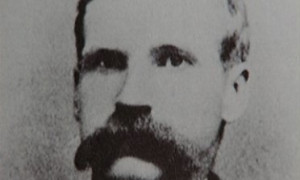Articles
Balance Rock is a famous boulder situated on Long (formerly Manitou) Island in the middle of Lake Memphremagog. The rock has long been associated with Native legend. According to tradition, the Abenakis who used to inhabit the area believed that it guarded the entrance to the afterlife. It was a sacred place and few dared to venture near it.
Lake Memphremagog is located partly in Canada and partly in the United States. Europeans have been living around the lake for only the last two centuries; before their arrival, the area was occupied by the Abenakis, the indigenous people who gave the lake its name, which roughly translates as "beautiful waters."
The Council fire cast weird shadows amongst the trees and the waters of the river reflected its glow. The Chieftain of the Abenakai tribe, tall and commanding, with flashing eyes, but features calm and immovable, stood in the midst of the fire-lit circle. Addressing his tribesmen the Chieftain spoke thus:
On November 5, 1915, the Parliament of Canada issued an Order in Council authorizing the organization of the 117th Battalion, Canadian Expeditionary Force , to be recruited in Sherbrooke, Quebec.
Belgium, Nov 10th [1915]
Dear Carl,
I often think of you all especially when the full moon floats over head and wish I might drop in and see you all—
Upper Canada felt the sting in the opening days of the War of 1812. But for many residents of Lower Canada life continued as usual.
(Continued from Part 1)
In the lovely windswept high places of early 19th century Dunham, among old-growth forests and newly ploughed fields, where the earliest beginnings of tender apple shoots were beginning to take root, a sinister and corrupt enterprise thrived and threatened to destroy the placidity of the newly settled pastoral community.
In the 1860s, many Irishmen living in the United States wanted Britain to grant independence to Ireland. Ireland was under English rule and most of its people lived in severe poverty. The Irish potato famine of the 1840s had decimated Ireland's population and England had offered little help.
No account of the Eastern Townships would be complete without mentioning Rogers' Rangers and what has become one of the more infamous episodes in Townships lore. After the fall of Quebec in 1759, but before the war was completely over, British General Jeffery Amherst decided to punish the St.
THE REBELLIONS OF 1837-1838
(**Continued from The Rebellions Part 1: The Political Context)
The border separating Quebec’s Eastern Townships from the United States was determined by the terms of the Quebec Act in 1774. At that time, both Canada and the American colonies to the south were dependencies of Great Britain. The border was established – on paper at least -- at 45 degrees north latitude.
Smuggling has been a problem in the Eastern Townships for a long time. At first, there were no customs offices at all. People could buy whatever they pleased in the U.S. and bring it back over the border, no questions asked. In 1821, the government set up a border post at Stanstead. Some people paid the duty, but many continued to smuggle.
In the early 19th century, there were no police, courts, or prisons in the Eastern Townships. The region was a distant frontier, far from the cities of Lower Canada. In theory, the law was enforced by part-time magistrates living in the scattered settlements. In times of emergency, the magistrates were assisted by the local militia.
--July 3, 2019.
In honour of the 125th anniversary of "Megantic Outlaw" Donald Morrison's death, QAHN is pleased to re-issue the following short article on the response to Morrison's arrest by the Scottish community of the Eastern Townships.
The St. Albans Raid of October 19, 1864 is one of the most celebrated incidents in Border lore. Considered the northernmost engagement of the American Civil War, it involved about twenty Confederate soldiers who, under the command of a young lieutenant, Bennett Young, carried out a successful raid on three banks in St. Albans, Vermont.
Born in 1845 on his parents' farm at Kingscroft, in Barnston Township, Arthur Osmore Norton studied at nearby Barnston Academy. By age 16, Norton was working as a clerk in a local general store. In 1870, he married Helen Richardson of Coaticook. The couple would have two children together.
From 1860 to the early 1900s, the St. Francis Valley was the main centre in Canada for the production of slate. At that time, there were no less than ten slate quarries in the area around Richmond, Melbourne, Kingsey, and Danville. Entire villages grew up around the quarries which provided a living to hundreds of workers for the most part from Great Britain.
Three components make up the explosive combination of black powder: saltpeter (potassium nitrate), sulphur, and charcoal (carbon). In its heyday, black powder had two primary applications: blasting powder for use in mining operations, and gunpowder for hunting.
